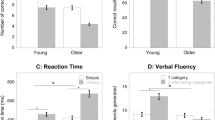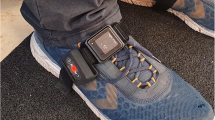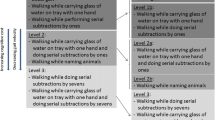Abstract
Aims: The purpose of this study was to examine relationships among gait and mobility under single and dual task conditions in older adults. Methods: Community-dwelling older adults (n=41, mean age=75) completed mobility and gait tasks. Mobility was assessed with the Timed-Up-and-Go (TUG). Select gait parameters were examined while individuals walked at their preferred speed across the GAITRite electronic walkway. Two age groups were studied (younger age group=65–75; older age group=76+). Multiple linear regression analyses were used to examine the relationship between gait and mobility under single vs dual conditions. Results: Older adults required more time to complete the TUG when concurrently performing a second cognitive task (10.84 sec vs 15.77 sec). In addition, one or more gait characteristic such as stride length, cadence and stance explained (a) a high percentage of variance in mobility performance under single task conditions (TUG 74%) and (b) a smaller portion of variance in mobility performance under dual task conditions (TUGc 25%). No salient age group differences were observed in TUG performance, but gait characteristics accounted for a larger portion of variance in TUGc performance (46%) for the older age group (mean age=81) than for the younger age group (mean age=69; TUGc 18%).
Similar content being viewed by others
References
Beauchet O, Allali G, Annweiler C et al. Does change in gait while counting backward predict the occurrence of a first fall in older adults? Gerontol 2008; 54: 217–23.
Hollman JH, Kovash FM, Kubik JJ, Linbo RA. Age-related differences in spatiotemporal markers of gait stability during dual task walking. Gait Posture 2007; 26: 113–9.
Siu KC, Lugade V, Chou LS, van Donkelaar P, Woollacott MH. Dual-task interference during obstacle clearance in healthy and balance- impaired older adults. Aging Clin Exp Res 2008; 20: 349–54.
Shumway-Cook A, Woollacott M, Kerns KA, Baldwin M. The effects of two types of cognitive tasks on postural stability in older adults with and without a history of falls. J Gerontol A Biol Sci Med Sci 1997; 52: M232–40.
Beauchet O, Dubost V, Herrmann F, Rabilloud M, Gonthier R, Kressig RW. Relationship between dual-task related gait changes and intrinsic risk factors for falls among transitional frail older adults. Aging Clin Exp Res 2005; 17: 270–5.
Yogev-Seligmann G, Rotem-Galili Y, Mirelman A, Dickstein R, Giladi N, Hausdorff JM. How does explicit prioritization alter walking during dual-task performance? Effects of age and sex on gait speed and variability. Phys Ther 2010; 90: 177–86.
Kizony R, Levin MF, Hughey L, Perez C, Fung J. Cognitive load and dual-task performance during locomotion poststroke: a feasibility study using a functional virtual environment. Phys Ther 2010; 90: 252–60.
Kressig RW, Herrmann FR, Grandjean R, Michel JP, Beauchet O. Gait variability while dual-tasking: fall predictor in older inpatients? Aging Clin Exp Res 2008; 20: 123–30.
Yang YR, Chen YC, Lee CS, Cheng SJ, Wang RY. Dual-task-related gait changes in individuals with stroke. Gait Posture 2007; 25: 185–90.
Woollacott M, Shumway-Cook A. Attention and the control of posture and gait: a review of an emerging area of research. Gait Posture 2002; 16: 1–14.
Hausdorff JM, Yogev G, Springer S, Simon ES, Giladi N. Walking is more like catching than tapping: gait in the elderly as a complex cognitive task. Exp Brain Res 2005; 164: 541–8.
Rosano C, Aizenstein H, Brach J, Longenberger A, Studenski S, Newman AB. Special article: gait measures indicate underlying focal gray matter atrophy in the brain of older adults. J Gerontol A Biol Sci Med Sci 2008; 63: 1380–8.
Springer S, Giladi N, Peretz C, Yogev G, Simon ES, Hausdorff JM. Dual-tasking effects on gait variability: the role of aging, falls, and executive function. Mov Disord 2006; 21: 950–7.
Allali G, Kressig RW, Assal F, Herrmann FR, Dubost V, Beauchet O. Changes in gait while backward counting in demented older adults with frontal lobe dysfunction. Gait Posture 2007; 26: 572–6.
Pashler H. Dual-task interference in simple tasks: data and theory. Psychol Bull 1994; 116: 220–44.
Beauchet O, Dubost V, Aminian K, Gonthier R, Kressig RW. Dual-task-related gait changes in the elderly: does the type of cognitive task matter? J Mot Behav 2005; 37: 259–64.
Spirduso WW, Francis KL, MacRae PG. Physical Dimensions of Aging. 2nd ed. Champaigne, IL: Human Kinetics, 2005.
Pondal M, del Ser T. Normative data and determinants for the timed “up and go” test in a population-based sample of elderly individuals without gait disturbances. J Geriatr Phys Ther 2008; 31: 57–63.
Ullmann G, Williams HG, Hussey J, Durstine JL, McClenaghan BA. Effects of Feldenkrais exercises on balance, mobility, balance confidence, and gait performance in community-dwelling adults age 65 and older. J Altern Complement Med 2010; 16: 97–105.
CIR Systems Inc. GAITRiteWalkway System. http://www.gaitrite.com
Kressig RW, Beauchet O. Guidelines for clinical applications of spatio-temporal gait analysis in older adults. Aging Clin Exp Res 2006; 18: 174–6.
Menz HB, Latt MD, Tiedemann A, Mun San Kwan M, Lord SR. Reliability of the GAITRite walkway system for the quantification of temporo-spatial parameters of gait in young and older people. Gait Posture 2004; 20: 20–5.
Podsiadlo D, Richardson S. The timed “Up & Go”: a test of basic functional mobility for frail elderly persons. J Am Geriatr Soc 1991; 39: 142–8.
Shumway-Cook A, Brauer S, Woollacott M. Predicting the probability for falls in community-dwelling older adults using the Timed Up & Go Test. Phys Ther 2000; 80: 896–903.
Shumway-Cook A, Woollacott M. Attentional demands and postural control: the effect of sensory context. J Gerontol A Biol Sci Med Sci 2000; 55: M10–6.
Shumway-Cook A, Brauer S, Woollacott M. The Timed Up & Go Test (TUG) — Research Report. Seattle, WA: University of Washington, 2000.
Steffen TM, Hacker TA, Mollinger L. Age- and gender-related test performance in community-dwelling elderly people: Six-Minute Walk Test, Berg Balance Scale, Timed Up & Go Test, and gait speeds. Phys Ther 2002; 82: 128–37.
Elble RJ, Thomas SS, Higgins C, Colliver J. Stride-dependent changes in gait of older people. J Neurol 1991; 238: 1–5.
Bohannon RW. Comfortable and maximum walking speed of adults aged 20-79 years: reference values and determinants. Age Ageing 1997; 26: 15–9.
Bohannon RW. Reference values for the timed up and go test: a descriptive meta-analysis. J Geriatr Phys Ther 2006; 29: 64–8.
Newton RA. Balance screening of an inner city older adult population. Arch Phys Med Rehabil 1997; 78: 587–91.
Callisaya ML, Blizzard L, Schmidt MD, McGinley JL, Srikanth VK. Ageing and gait variability — a population-based study of older people. Age Ageing 2010; 39: 191–7.
Author information
Authors and Affiliations
Corresponding author
Rights and permissions
About this article
Cite this article
Ullmann, G., Williams, H.G. The relationships among gait and mobility under single and dual task conditions in community-dwelling older adults. Aging Clin Exp Res 23, 400–405 (2011). https://doi.org/10.1007/BF03337765
Received:
Accepted:
Published:
Issue Date:
DOI: https://doi.org/10.1007/BF03337765




